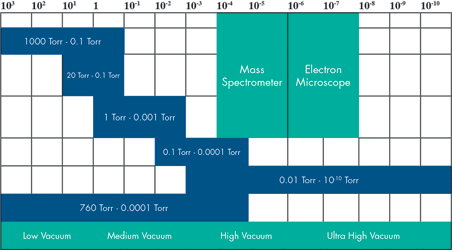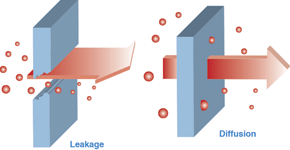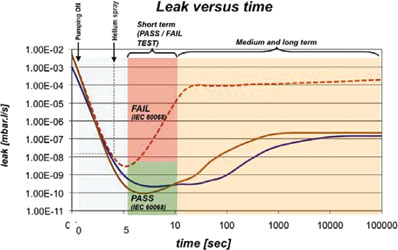
Sealed connectors are used in many applications where leakage into or out of equipment must be avoided. Sealing is a very complex science in itself, as it involves many physical aspects including mechanical design, materials science, surface science and fluid behaviour.
Three major application groups exist that require different sealing levels and different solutions: environmental sealing, hermetic sealing and high pressure sealing. This article focuses on hermetic sealing as encountered in many application areas, specifically as it relates to gas and tightness.
Sealing categories
Three major application groups exist that require different sealing levels and therefore call for different solutions.
Environmental sealing
In typical outdoor applications, one side of the connector might be exposed to rain, dust and other aggressive environments. The exposure is generally limited in time and pressure. Fischer Connectors’ product range for these applications includes receptacles sealed in mated or unmated states; for example, styles DEU, DBEU, DBPU, etc., as well as plugs in association with sealed clamp sets. These products are designed to offer sealing up to IP68.
Hermetic sealing
Hermeticity is required for gas tightness, for example in vacuum applications or pressurised vessels. These applications require a high level of sealing to prevent gas leaks over longer periods of time.
These product ranges, for example Fischer styles DEE, DBEE, DBPE, etc., are designed specifically for hermetic sealing and undergo a 100% leak test. Such connectors can also be used in other severe conditions like immersion for longer periods of time or exposure to strong water jets. They achieve an IP69K rating.
High pressure sealing
For applications requiring exposure for extended periods of time in liquids under high pressure (for example, deep submarine applications), special designs can be proposed that combine hermetic sealing with high-strength mechanical design. Fischer Connectors’ design centre can assist customers with such special requests.
Hermeticity
Hermeticity is one of the toughest challenges when specifying connectors. In order to successfully specify an airtight, hermetically sealed connector solution, it is important to understand the function of the specific vacuum application and how connectors can and should be manufactured to minimise or stop gases from leaking into or out of the vacuum chamber.
Vacuum
Vacuum sealing is used in many applications, including aerospace, sensor and test equipment, mass spectrometers and underwater equipment. These applications require the tightest sealing that will not just keep dust and water out, but will provide a barrier to gasses down to the molecular level.
A vacuum is made when gas molecules are taken out from a chamber. In order to achieve specific physical reactions, a vacuum has to be created in a chamber so that air molecules will act as a barrier for other molecules or electrons. For example, a mass spectrometer or an electron microscope needs a vacuum chamber to work properly, but it also needs a connector so that the measurements can be recorded accurately.

Atmospheric pressure is equal to one bar = 1000 millibars (mbar). Depending on the application, different vacuum levels have to be achieved within the chamber. 10 mbar is defined as ‘low vacuum,’ 1E-5 mbar as ‘high vacuum’ and 1E-7 mbar as ‘ultra-high vacuum’.
Hermetic connectors and leak unit
If a connector is placed on the vacuum chamber, the air going through the connector over time must be as small as possible. The connector has to be hermetic, in that it does not allow air molecules to enter the vacuum chamber. If the connector is not hermetic, it will allow air into the vacuum chamber, which will increase the residual pressure and prevent the equipment from working properly.

A quantity of air (or other gas) going through a connector is a leak. In order to quantify a leak, the leak unit is based on a certain volume of gas per second going through it. The scientific unit is the mbar.l/s.
In the vacuum industry, 5E-7 mbar.l/s is considered a very small leak that will not impair most vacuum applications. 1E-4 mbar.l/s is considered a big leak, and only very rare low-vacuum applications can afford such a leak in the vacuum chamber.
Pressure gradient and gas type effect on leaks
The standard gradient is 1 bar. It is never possible to achieve more than a 1 bar differential pressure because a vacuum chamber cannot have less than zero air molecules in it. A low vacuum of 10 mbar will induce a pressure differential with atmospheric pressure (1000 mbar) of 990 mbar. An ultra-high vacuum of 1E-7 mbar (0,0000000001 bar) will induce a differential of 0,9999999999 bar.
A given leak for a given connector will not be the same if the connector is exposed to an overpressure. If the vacuum chamber is replaced by a 10 bar pressurised chamber, the leak will be bigger.

Since the most common leak measurement equipment is the helium tracer, a leak is often given as a helium leak. However, vacuum applications are not working with helium; that is why the leak can be given for air molecules. Air leaks 2,6 times less than helium (standard calculation based on square root quotient of molecular mass of N2 and He). If a connector leak is measured under a helium atmosphere as being 4E-7 mbar.l/s, the real vacuum application (air) will have a leak of 1,5E- 7 mbar.l/s.
Leak over time
It is very important that engineers identify and select the proper material for O-rings when working with hermitically sealed connectors. The presence of defects or cracks in the barrier will cause gases to flow through. In general, those types of defects will result in gross leakage and failure of the device. But even a barrier without defects will allow gases to diffuse through it; this is called permeation or diffusion.
Diffusion is known to occur in most plastics and rubber materials, allowing extremely small quantities of gas to migrate through the hermetic barrier. This can happen when the O-ring is exposed to a pressure gradient and the gas molecules (nitrogen, helium, oxygen) progressively go slowly, or diffuse, into the O-ring and out the other side.
This phenomenon cannot be observed after only a few seconds, but will become predominant after a few minutes. The diffusion leak is difficult to measure because the air diffuses through an O-ring material that is sealing the connector, and there is no single measurement point.
For this reason, components like connectors or other devices mounted on hermetic systems will exhibit a residual leakage resulting from gas diffusion through the sealing material. The optimised design of these components and adequate material selection allows the residual leakage rate to remain at extremely low values, suitable for most ultra-vacuum applications.
The understanding of these mechanisms is important; the leaking through tiny cracks is often related to the failure of the hermetic device, whereas diffusion is a natural phenomenon existing in most systems that can be limited only with very special technologies.
The standard IEC60068-2-17-Qk method 3 alternative b for leak measurement is a ‘short term leak.’ The usual way to qualify connector hermeticity is to measure this leak by spraying helium on the connector and using a helium tracer to measure the quantity of helium going through it.
This test detects leaking connectors without measuring the real, long-term leak value. If the leak threshold is put at 1E-8 mbar.l/s as done at Fischer Connectors, this test can also very efficiently sort out the connectors that would be problematic for vacuum applications.
Lower thresholds (1E- 9 mbar.l/s or 1E-10 mbar.l/s) are not relevant because the diffusion leak through O-rings will simply go to higher values after a few minutes. Even if the diffusion effect depends on many factors, a value for standard size connectors of 1,5 E-7mbar.l/s (air) can be given as a medium- and long-term leak value (equivalent to a leak of 4E-7 mbar.l/s for helium).
Virtual leaks and outgassing
Gas trapped between assembled components or contained inside materials will slowly migrate out of the device into the vacuum area. This common phenomenon will impact the rate at which the desired vacuum level will be attained; such factors must be taken into account, especially during initial pump down, until all these gases are released.
‘Virtual leaks’ result from trapped volumes. They are called virtual leaks because their effect is similar to a small leak for a short period of time during which gas is released, and in some circumstances, they can hardly be distinguished from a real leak.
Typical virtual leaks result from trapped air in bores for screws, or between assembled parts showing large surfaces in contact. Normally, virtual leaks will not be identified using tracer gas methods, as this gas applied to the outside will not penetrate into the trapped cavity.
Virtual leaks will increase the gas load and affect pump-down time, or in some cases, the gas can exit the trap, resulting in a sudden increase of pressure in the chamber. When installing a connector onto a vacuum system, it is important to verify that no gas is trapped in the mounting area.
Many materials used in connector design, insulating plastics, sealing resins and elastomeric seals will naturally absorb a small quantity of water. The water molecules, as well as other gases in solution, will be released under vacuum (also called desorption) increasing the gas load in the initial pumping phase. Polymer materials typically contain 0,1-0,5% humidity, depending on grade and storage history. Desorption can be accelerated by baking (heating).
Fischer Connectors’ hermetic products are designed to minimise both effects.
Connector installation

Correct panel sealing can be achieved only if the contact surface for the connector interface seal is correctly prepared. Special care must be taken depending on manufacturing techniques. The following aspects are most commonly encountered in seal designs:
* The surface flatness shall be designed in such a way that sealing can be achieved without excessive torque required to mount the connector. Typical recommended flatness is <0,05 mm, usually not problematic for modern machining techniques.
* Machining grooves should be circular and not perpendicular to the O-ring seal – see Figure 4.
If, however, circular machining is not possible, reasonable sealing performance can be obtained if surface roughness is <Ra 0,8 m. Use of a vacuum grease is to be evaluated depending on the application. Edges and burrs of panel cut-outs should be carefully cleaned.

© Technews Publishing (Pty) Ltd | All Rights Reserved